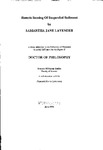Remote Sensing Of Suspended Sediment
| dc.contributor.author | LAVENDER, SAMANTHA JANE | |
| dc.contributor.other | Faculty of Science and Engineering | en_US |
| dc.date.accessioned | 2013-10-09T11:13:04Z | |
| dc.date.available | 2013-10-09T11:13:04Z | |
| dc.date.issued | 1996 | |
| dc.identifier | NOT AVAILABLE | en_US |
| dc.identifier.uri | http://hdl.handle.net/10026.1/2119 | |
| dc.description.abstract |
A remote sensing near infrared suspended sediment algorithm is developed from first principles and applied to Compact Airborne Spectrographic Imagery (CASI) data flown over the Humber Estuary. Laboratory measurements were used as the basis for the algorithm development, with the resulting spectra indicating that the ideal wavelength for a suspended sediment algorithm is the near infrared. The resulting algorithm took the form of a waveband ratio which was subsequently validated with a semi-analytical water optics model based on the absorption/scattering properties of the optically active constituents. The model was then used to derive a global water-leaving radiance algorithm, which is independent of the sediment type. The algorithm was applied to the CASI data collected during August and September 1993, and the resulting SPM maps were compared with contemporaneous in-situ measurements. The in-situ measurements include calculations of the diffuse attenuation coefficient (Kd), which was correlated with the SPM concentration. Further developments to the algorithm through the use of an atmospheric correction are outlined. | en_US |
| dc.description.sponsorship | Plymouth Marine Laboratory | en_US |
| dc.language.iso | en | en_US |
| dc.publisher | University of Plymouth | en_US |
| dc.title | Remote Sensing Of Suspended Sediment | en_US |
| dc.type | Thesis | |
| plymouth.version | Full version | en_US |
| dc.identifier.doi | http://dx.doi.org/10.24382/4508 |
Files in this item
This item appears in the following Collection(s)
-
01 Research Theses Main Collection
Research Theses Main


